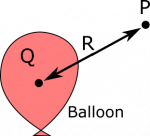Example: Electric Potential from a Negatively Charged Balloon
Suppose we have a negatively charged balloon with total charge $Q=-5.0\cdot 10^{-9} \text{ C}$. What is the electric potential (also called voltage) at a point $P$, which is a distance $R=20 \text{ m}$ from the center of the balloon?
Facts
- The balloon has total charge $Q=-5.0\cdot 10^{-9} \text{ C}$.
- The point $P$ is a distance $R=20 \text{ m}$ away from the center of the balloon.
- The electric potential due to a point charge can be written as $$V = \frac{1}{4\pi\epsilon_0}\frac{q}{r},$$ where $q$ represents the charge and $r$ is the distance.
Representations
Assumption
We assume $P$ lies outside of the balloon. This is obvious, as $P$ is a distance $R=20 \text{ m}$ away from the center of the balloon.
Goal
- Find the electric potential at $P$.
Solution
Approximation
We approximate the balloon as a point charge. We do this because we have the tools to find the electric potential from a point charge. This seems like a reasonable approximation because the balloon is not too spread out, and we are interested in a point very far from the balloon, so the balloon would “look” like a point charge from the perspective of an observation location that is $20 \text{ m}$ away.
Assumption
The electric potential infinitely far away from the balloon is $0 \text{ V}$. Read here for why this is important.
The electric potential at $P$ is given by \begin{align*} V &= \frac{1}{4\pi\epsilon_0}\frac{q}{r} \\ &= \frac{1}{4\pi\cdot 8.85\cdot 10^{-12} \frac{\text{C}}{\text{Vm}}}\frac{-5.0\cdot 10^{-9} \text{ C}}{20 \text{ m}} \\ &= -2.2 \text{ V} \end{align*} Notice how the magnitude of charge on the balloon is the same as in the “positively charged balloon” example. The reason the magnitude of the voltage is so much smaller, is because the distance is so much greater. The closer you get to a point charge, the higher the magnitude of electric potential.
